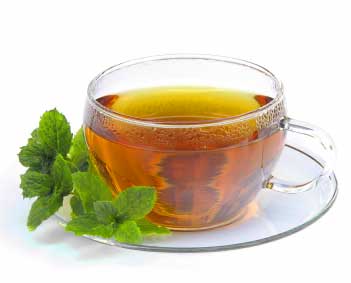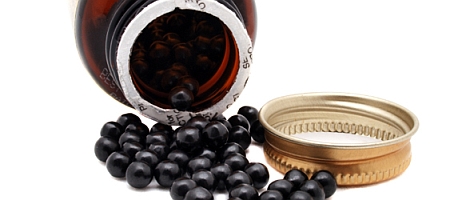
Juice
This is usually made by mashing and squeezing the herb material through a filter.
Many fruits such as oranges, apples, grape, lemons and limes are commonly used
as juices.
Also vegetables such as parsley, celery, garlic and onions can be juiced.
These juices maintain maximum potency and freshness of the plant, however generally
can not be stored at room temperature for very long.

Infusions
The common cup of tea is a good example of an infusion. (Camellia sinensis)
Basic infusions are made by adding 1 or 2 teaspoons of dried herbs or 2 to 4
teaspoons of fresh herbs to one cup of boiling water. Infuse for ten minutes
before straining. If the herb is left too long, the infusion will become bitter.
Avoid metal vessels. Ceramic or heat proof glass is best. The standard dosage
is one cup three times per day, taken hot or cold. Infusions for colds and flu
should be taken hot. Infusions should be prepared on the day they are to be
used.
Infusions use water as the solvent, which penetrates into plant cells by osmosis.
This creates a high intracellular pressure which breaks the cell open and releases
the contents. Heat helps speed up this process Generally infusions are made
of flowers or leaves which are not difficult for water to penetrate and supply
quite a strong dose of herb compared to the more costly fluid extracts. eg Lemon
balm, Elder flower. Solid parts of plant, such as bark, wood or root need to
be reduced to a small size by grinding or hammermilling so that water can penetrate.
Concoction
These are a mixture of herbs boiled in water, where the herbs are not strained
out of the mixture but consumed like a soup. eg Lycium berry.
 Capsules
Capsules
Dried herbs can be put into capsules for swallowing. An example is slippery
elm. The powder is difficult to swallow so a convenient form is capsules. Capsules
of herbs can be made using empty capsules can be found at your local health
food store or through mail-order. Grind the dried herbs as near to a powder
as you can. The empty capsules can be pulled in half, and the herb powder added.
There are small capping machines that can cap around 50 at a time.
Sugar is a good preservative and is ideal for cough mixtures, especially since some herbs are bitter. Prepare two parts of an infusion or decoction of the required herb. Strain and add 1 3/4 parts brown sugar or a honey and sugar mixture. Heat gently until the sugar dissolves. Pour into a clean glass bottle and seal. Store in refrigerator.
Tinctures
A tincture is an alcoholic extraction of herb. Alcohol dissolves the active
properties out of the plant and acts as a preservative, allowing the tincture
to retain its effectiveness for up to two years. Any part of the plant may be
used. Place four ounces of dried herb in a glass jar with a tight fitting lid
and add two cups of vodka. Leave for two weeks, shaking occasionally, then strain
through a cloth into a brown glass bottle. Keep tightly closed and away from
direct light. The standard dosage is 15 drops three times daily.
Herbal Wine
Use sweet red wine with an alcohol content of at least 12%. Cover four ounces
of herb with three cups of wine. Allow to sit for three weeks, then strain.
Take four teaspoons, once or twice daily. Use within one month. Ginseng can
be preserved in various types of ginseng wine.
Herbs with liquor
A herbal product can be preserved in most types of spirits. eg Raisins preserved
in vodka is used for rheumatic/arthritic pain.
Freeze dried herb
Freeze-drying, is a dehydration process typically used to preserve
a perishable material or make the material more convenient for transport. Freeze-drying
works by freezing the material and then reducing the surrounding pressure to
allow the frozen water in the material to sublimate directly from the solid
phase to the gas phase.
 Concentrated
decoction
Concentrated
decoction
Freeze drying is often used for teas. The herbs are boiled and the
herbs are then removed from the water. The remaining tea is then evaporated
at room temperature. The material that is left is a highly potent herbal product.
The patent medicines made in China are a good example of this.
Oil infusions
A solvent oil such as virgin olive oil is poured over the fresh herb in a large
glass container. The mixture is left for several months for the constituents
to be leached into the oil. The mixture is then sieved removing the herb from
the oil. Examples of herbs using this technique are: St John's Wort flower,
Mullein flower, Arnica
Loosely pack a jar with desired herb. Fill with virgin olive oil, making sure
all plant material is submerged. Place in a sunny spot for 6 weeks - 3 months,
rotate by turning jar upside down and up once a day. Strain into clean colored
glass bottles or jars. Mullein flowers are processed in this way.
Compresses
Reduce the fresh herb to its essence by boiling to extract its soluble
properties. Dip a cloth into the hot liquid, squeeze out the excess and apply
the hot cloth to the affected area. Repeat the process when the cloth cools.
An example is using chrysanthemum tea for irritated hot eyes.
Creams
A good quality cream is obtainedby mixing Aqueous cream from the chemist with
20% powder/ fluid extract/oil. This mixture has a shelf life of around 6 months.
All externally applied liniments, and healing creams work well in this mixture.
Ointments
Whereas creams penetrate the skin, ointments cover and protect it. Use petroleum
jelly as your base. Melt it in a double boiler and add lots of herbs, making
sure that the melted jelly covers them. Simmer until the herbs are crisp. More
herbs may be added to make the ointment stronger. Strain into jars while hot.
Mix Creams are a blend of oil and beeswax. To make your own, melt two ounces
of beeswax in a double boiler, add one cup olive oil and blend. Add two ounces
of your herb. Simmer for 20 minutes, mixing well. Add a drop of tincture of
benzoin as a preservative. Strain through a cloth into a sterilized jar. Or,
purchase an unscented, water based cream. Add the herb to the cream, simmer
in a double boiler for 30 minutes, and strain.
Plasters
Plasters are herbal powders mixed with cornstarch and applied to the affected
area to provide heat, reduce swelling, or allow for absorption of the herb into
the chest or other area. Some plasters can actually burn the skin, so the mixture
is usually wrapped in cloth. This also facilitates easy removal.
Poultices
Poultices are good for boils, abscesses, chest infections and sprains. Mix chopped
herb or powdered seeds with boiling water to make a pulp. Place the pulp in
a piece of cloth and apply to the affected area while hot. It should be replaced
when cool. A thin layer of cream will protect the skin and prevent the poultice
from sticking.
Steam, Inhalants
Use steam for skin problems like acne and an inhalant for bronchial problems.
Add a strong decoction, one or two drops of essential oils, or 2 teaspoons of
tincture to boiling water.
Images
1. liveoakacupuncture.com